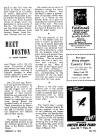
Home Page Meet Boston Menu Index
|
MEET BOSTON Friday, February 6, 1942 in What's New In Town W. J. Sidis |
Due to the fact that the City of Boston was originally made up of a number of towns, duplication of street names has been a major problem hereabouts. There are still over three hundred names of streets which are duplicated in various parts of the city. For instance there are five Washington Streets, three Warren Avenues, three Harvard Streets, three Harvard Avenues, and five Harvard Places, within the city limits. Elimination of these duplications has been taking place gradually, resulting in frequent changes in street names, especially in the suburban districts of Boston.
*
Until 25 years ago, Brookline was governed directly by meetings of its citizens. It was the largest unit in the world to have ever been governed in that manner. Brookline was separated from Boston in 1705, and has retained its independence ever since, though Boston has annexed nearly all around it. These annexations by Boston have isolated Brookline from the rest of Norfolk County; but Brookline remains part of that county.
*
The highest structure anywhere devoted to use for national government offices, is the Boston Custom House.
*
We usually do not think of Needham among the towns bordering Boston. And yet there is about a quarter-mile of boundary which they share, in a marsh on the Charles River, at a spot not accessible by road from either side of the river. The land at this boundary belongs to the town of Brookline, and is used for water works.
*
The vast majority of the hills in the Boston area are what is known as drumlins, made up of gravel deposited by the Great Ice Sheet. The material was obtained from the White Mountains, where the ice pressure broke off great rocks and ground them into gravel before they got to Boston. The ice moulded these hills into fairly uniform oval shape, well rounded on top. Most of the hills of this region point in the same direction―northwesterly and southeasterly, corresponding to the movement of the ice sheet. And the ice seems to have gone back for more rocks.
*
Boston is the only major Atlantic port where it would be practicable to operate boat trains extensively―that is, trains direct to the piers to meet ocean ships.
*
The “public alley”―a special alley between streets for delivery wagons―is an item of city planning not known to any other city besides Boston. This feature is prevalent in sections of the city settled in the period immediately following the Civil War, such as the Back Bay, parts of the South End, and the river slope of Beacon Hill.